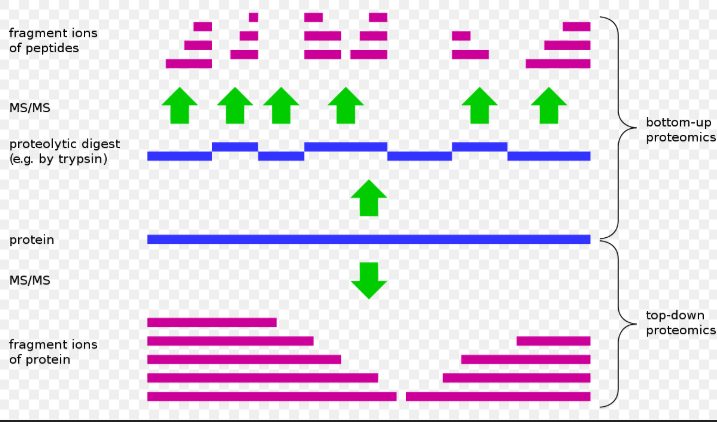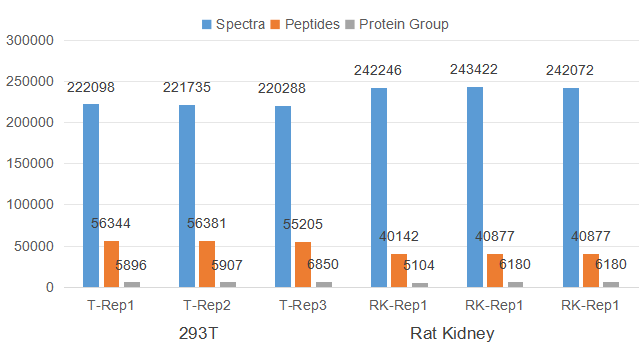
In today's biomedical research landscape, proteomics is increasingly becoming a key technology for unraveling biological complexities and understanding disease mechanisms. Through precise protein analysis, scientists can delve into the expression, regulation, and interactions of proteins, thereby driving innovations in pharmaceutical research and clinical diagnostics. This article will provide a detailed overview of the core strategies and contents of proteomics research, including bottom-up and top-down analytical methods, and how these technologies are applied to the discovery and validation of disease biomarkers.
 In proteomics, two primary methods are employed for qualitative protein analysis (figure 1): Bottom-up and Top-down. Top-down involves fragmenting intact proteins using mass spectrometry and inferring the protein sequence from the detected fragments. However, the most commonly utilized method is Bottom-up, also known as the shotgun approach, which capitalizes on the protein's enzymatic cleavage at specific sites. The fundamental concept of Bottom-up entails enzymatically digesting the protein sequence into peptides, identifying the resulting peptide fragments, and deducing the protein sequence from these peptides. The methodologies discussed later in this document all adhere to the Bottom-up strategy.
In proteomics, two primary methods are employed for qualitative protein analysis (figure 1): Bottom-up and Top-down. Top-down involves fragmenting intact proteins using mass spectrometry and inferring the protein sequence from the detected fragments. However, the most commonly utilized method is Bottom-up, also known as the shotgun approach, which capitalizes on the protein's enzymatic cleavage at specific sites. The fundamental concept of Bottom-up entails enzymatically digesting the protein sequence into peptides, identifying the resulting peptide fragments, and deducing the protein sequence from these peptides. The methodologies discussed later in this document all adhere to the Bottom-up strategy.
Typically, the technical route of proteomics involves several steps:
Proteomics studies encompass a wide range of biological samples, including cell lines (e.g., 293T, Hela), tissues (e.g., liver, kidney), microbial cells, and various body fluids (e.g., urine, serum/plasma). In the initial step, known as sample preprocessing, the aim is to extract proteins from the sample as comprehensively as possible. The methods employed at this stage vary depending on the sample type and experimental objectives, as discussed in subsequent sections.
Proteins undergo enzymatic cleavage using sequence-specific enzymes such as Trypsin, Glu-C, or Lys-C to produce a mixture of peptide fragments.
After enzymatic digestion, peptides are fed into nano-HPLC, also referred to as LC in LC-MS. Through pre-separation based on chromatographic retention time, peptides are sequentially introduced into mass spectrometry for detection within precise time intervals.
Separated peptides undergo ionization in the mass spectrometer's ion source (commonly Electrospray Ionization or Matrix-Assisted Laser Desorption/Ionization). Neutral peptides are ionized to form positively charged peptide ions, which are then analyzed by the mass analyzer. The mass analyzer separates peptide ions with different mass-to-charge ratios, generating primary and secondary mass spectra that record the mass-to-charge ratio, signal intensity, and retention time of peptide ions and their fragment ions.
Automated analysis of mass spectra using proteomics search software provides peptide and protein sequence information, facilitating protein identification. For quantitative proteomics, peptide/protein expression levels and trends are inferred from the signal intensities of precursor or fragment ions recorded by the mass spectrometer. The current fundamental strategy for mass spectrometry data interpretation involves comparing protein sequences translated from coding genes inferred from genomic sequencing data with mass spectrometry data to achieve protein identification. (The principles of mass spectrometry data interpretation will be elaborated on separately in this series.)
The core focus of proteomics research encompasses the examination of proteome diversity, alterations in protein expression levels, post-translational modifications, protein-protein interactions, and their implications in biological processes. Subsequent sections will offer an elaborate exposition on each facet.
Protein identification entails the comprehensive identification of protein components within a given biological sample. In theory, proteomics techniques can discern thousands, or even tens of thousands, of proteins in a single analysis. However, this capability hinges on sample preprocessing methods and the sensitivity and resolution of the mass spectrometer.
Qualitative analysis in proteomics follows a relatively straightforward methodology, as outlined in the preceding section. However, the approach may vary depending on specific requirements. For example, when studying bodily fluids like plasma or serum, it's often necessary to remove high-abundance proteins to prevent their interference with the detection of low-abundance proteins. Similarly, investigating post-translational modified proteins, which typically exhibit low expression levels, necessitates their enrichment during sample preprocessing (typically by digesting total extracted proteins into peptides and then enriching the peptides) before conducting mass spectrometry analysis.
Studying various biological phenomena and diseases from the perspective of proteins, the direct executors of life processes, has become a trend in biological research. This often involves investigating the types and expression levels of proteins in cells, tissues, or organs, as well as studying changes in protein expression levels under different conditions or at different stages. Thus, protein identification and quantification are indispensable. Consequently, quantitative proteomics techniques have rapidly developed since the 21st century, giving rise to various quantification methods such as label-free quantification based on spectral counting, label-free quantification based on chromatographic peak area extraction, iTRAQ/TMT labeling quantification, SILAC quantification, and the recently proposed SWATH/DIA quantification based on data-independent acquisition (DIA) mode.
Before understanding the principle of protein quantification technology, it is first necessary to clarify the meaning of quantification in proteomics. In proteomics, "quantification" generally refers to relative quantification, which involves determining changes in the expression levels of a protein across different samples. For example, by comparing the proteomic data of gastric cancer tissues with adjacent normal tissues, one can obtain information on the changes in protein expression levels between cancer and normal tissues, aiming to identify proteins associated with gastric cancer occurrence.
In mass spectrometry-based quantitative proteomics strategies, the main principle is that the amount of peptides in a sample is proportional to the signal intensity detected by the mass spectrometer. Therefore, peptide signal intensity can be used to characterize peptide abundance, thereby inferring protein expression levels and calculating the relative abundance ratios of each protein across different samples (i.e., differential expression multiples).
Post-translational modifications (PTMs) are vital pathways for cells to rapidly and reversibly regulate protein functions. Over 50% of mammalian proteins rely on PTMs to achieve their specific physiological functions. Currently, the Uniprot protein database has cataloged over 450 types of PTMs, including prominent ones like phosphorylation, lysine acetylation, ubiquitination, and glycosylation. PTM proteomics research follows a process similar to classical proteomics but demands more effective analytical techniques due to the relatively low abundance and dynamic nature of PTM proteins within cells. This approach typically involves sample preprocessing, peptide fractionation, enrichment of modified peptides, mass spectrometry analysis, and bioinformatics interpretation.
PTM proteomics primarily focuses on two aspects: pinpointing amino acid residues undergoing post-translational modifications within protein sequences and conducting relative quantitative analysis of these modified sites. The former enables precise identification of specific modified amino acid positions on a particular protein, while the latter evaluates the physiological and pathological implications of PTMs by comparing their expression levels across different samples.
Interactome proteomics is a methodology in proteomics that utilizes mass spectrometry to conduct large-scale qualitative or quantitative studies on protein-protein, protein-nucleic acid, and protein-drug/small molecule interactions. This approach employs affinity separation techniques such as immunoprecipitation (IP) or pull-down to isolate protein complexes that bind to specific molecules. Leveraging the advantages of proteomics for large-scale qualitative or quantitative analysis, the isolated protein complexes are then dissected. Interactome proteomics serves as a powerful tool for investigating interactions between proteins and biological molecules or drugs.
Compared to traditional methods for studying protein interactions, mass spectrometry-based interactome proteomics offers several advantages:
a) Enables large-scale studies, facilitating more efficient exploration and identification of interacting proteins.
b) Provides a comprehensive depiction and reflection of protein interaction networks.
c) Open-ended research and extensive information may lead to more innovative discoveries.
a) Abundant protein detection and high sample detection stability

Secondary spectras, peptides and protein groups detected from 3 replicates of 293T cell samples and rat kidney samples.
b) High qualitative repeatability and accuracy

The proportion of peptides/proteins shared between the 3 replicates in different samples. BL: rape leaves; BR: rape roots; BS: rape stems; RK: rat kidney.
c) High quantitative stability and reproducibility

Correlation analysis in three replicates of different samples. T: 293T cells; BL: rape leaves; BR: rape roots; BS: rape stems; RK: ratkidney.
As proteomics technologies rapidly advance, choosing a leading provider of proteomics services becomes critically important. MetwareBio, with its advanced technological platform and robust scientific expertise, has established itself as a preferred partner for proteomics research worldwide. Whether it's protein identification, quantitative analysis, or post-translational modification studies, MetwareBio offers services with high accuracy and repeatability, helping researchers accelerate scientific discoveries and innovation. For more information, please visit our DIA Quantitative Proteomics Service.
